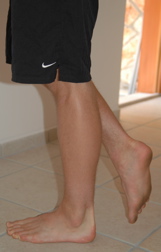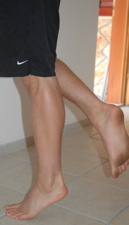
It also works other leg muscle groups, especially the front-thigh muscles including the VMO. It is an excellent balance exercise. In children it is useful following growth spurts. In older age it is invaluable for maintaining good leg strength for walking, especially going up and down stairs and slopes.
Position: Stand on one leg, close to a solid support, with your head straight and up, back straight, and shoulders and arms relaxed.
Movement: Raise the heel of the standing leg off the floor to go up on to your toes, and tighten your thigh muscles to lock your knee straight. Hold for a count of 1, then slowly lower your heel, relaxing your thigh muscles as the heel touches the floor. Repetitions and frequency: 3-10 times, 1-5 times a day
Repetitions and frequency: 3-10 times, 1-5 times a day
Note: Avoid pain. Do not do this exercise if you have recently suffered from calf cramps. Use the support if necessary, but try not to lean your whole weight on it. Make sure your knee stays locked straight during the movement. Keep your weight over the ball of the big toe, and relax your toes. If you find it difficult to relax your kneecap once your heel is on the floor, look in a mirror to make sure the kneecap has released before you repeat the exercise. Try to do each set of repetitions without putting the other leg down. If one leg is weaker than the other, do more repetitions or more sets for the weaker side until your leg strength is equal on both sides.
After injury: For any leg injury, especially calf and Achilles tendon pain or tears, knee problems or ankle sprains. In lower leg injuries, it is a late-stage exercise, but after some knee problems it can be done at an early stage, depending on pain. It helps to correct limping. After injury, it is essential to regain the ability to perform this movement before returning to sports involving running and jumping, particularly explosive sports such as sprinting, triple jump, squash, field hockey and basketball.


